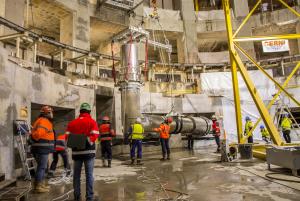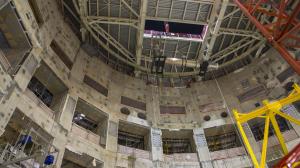First machine component enters the tokamak pit
A new chapter opened last night in the history of ITER construction as the first machine component entered the tokamak pit through the narrow opening in the bioshield lid.
The sun had just set on the ITER worksite when the cryostat feedthrough for poloidal field coil #4—a big, shiny stainless-steel pipe bent at a 90° angle—was slowly lifted from the Hot Cell zone to be deposited on the third level of the Tokamak Building.
For Patrick Petit, ITER In-Cryostat Assembly Section leader, the faultless operation carried out on 26 November "demonstrated that we are ready to commence the assembly of the ITER tokamak. We still have a lot of preparation work ahead of us but tonight marks the symbolic beginning of five years of intense assembly activities."



